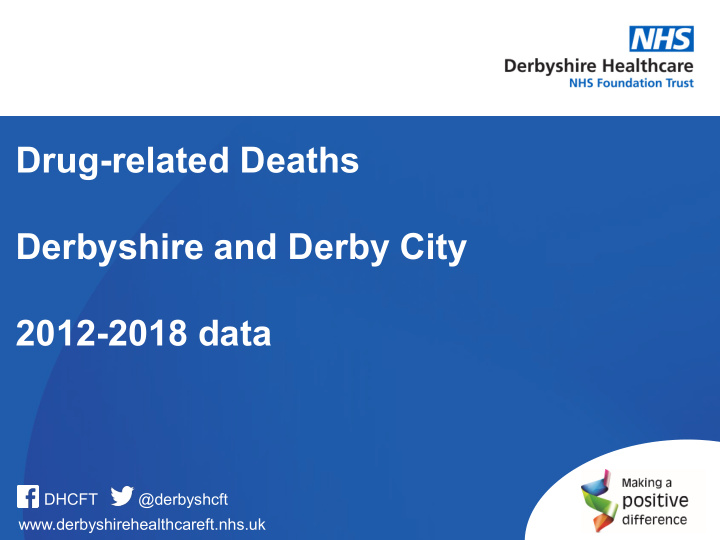



Drug-related Deaths Derbyshire and Derby City 2012-2018 data DHCFT @derbyshcft www.derbyshirehealthcareft.nhs.uk
Deaths by year 30 25 20 Number of deaths 15 City County 10 5 0 2012 2013 2014 2015 2016 2017 2018 Year The number of drug-related deaths in the region have been increasing since 2012. There was a total of 19 deaths in 2012, which rose to 42 by 2018. This figure is set to be even higher in 2019, with 42 deaths having already been recorded by October.
Age The average age at 60 death was 42 50 40 Number of deaths 30 20 10 0 20-24 25-29 30-34 35-39 40-44 45-49 50-54 55-59 60-64 65-69 70-74 Age group Those in substance misuse services seem to be dying from a multitude of complications at a younger age than would be typically expected of the general population The most common age group was 35-39 year olds
Causes of death Various causes of death have been noted. To name a few: • Overdose (98) • Suicide • Hepatitis C • Cancer • COPD • Liver disease • Sepsis • Multiple organ failure • Endocarditis • Pneumonia • Heart disease • Internal bleeding • Respiratory failure • Murder
Overdose deaths Younger age groups seem to be more at risk of death due to overdose than older age groups. Those 45+ show comparatively lower overdose deaths than younger service users, suggesting that these individuals are dying of other causes. 18 16 14 12 Number of deaths 10 Total no of overdose deaths 8 Overdoses aged 45+ 6 4 2 0 2012 2013 2014 2015 2016 2017 2018 Year
Physical Health Service users suffered from numerous physical health conditions. 98/238 deaths were overdose deaths, meaning 58.8% of deaths were attributable to other causes – many of these being a direct result of physical health complications linked to drug use. Many had more than 2 serious health conditions, as shown below: 80.00% 70.00% 60.00% Percentage of service users 50.00% 40.00% 30.00% 20.00% 10.00% 0.00% 2012 2013 2014 2015 2016 2017 2018 Year
Mental Health Only 39 145 of those that died had a formal mental health diagnosis, Individuals of which the most common were: had contact with MH services 36.6% 100 had a 87 90 diagnosis 80 of 70 depression 60 50 40 26 30 22 20 14 10 3 2 0
Circumstances 57.6% of service users died alone 31.9% died in hospital 10.5% died in the presence of friends 160 140 120 Number of service users 100 80 60 40 20 0 Alone Friends Hospital Circumstances of death
Sociodemographic characteristics 93.7% were 250 unemployed 230 223 200 188 173 166 Number of service users 72.7% 150 had hospital admissions in last 12 100 months 50 30 79% had a 0 history of Living in isolation Historical IV use Hospital Smoking Prison release Unemployed admissions* IV drug Sociodemogprahic factors use *hospital admissions in last 12 months
10 9 8 7 Number of service users 6 Pregabalin 5 Gabapentin 4 Mirtazapine 3 2 1 0 2012 2013 2014 2015 2016 2017 2018 Year
Attending Factors • 81 had a diagnosis of COPD • 82 had a diagnosis of Hepatitis C • 40 End of Life Care • 201 receiving other medication from their GPs, Pregabalin/Gabs, Anti Depressants, pain medication. • Sepsis/Endocarditis-Is there a correlation?
End of Life Care • Inequalities in palliative and end of life care have been recognised among some groups, including people with conditions other than cancer, those with dementia people from black and minority ethnic groups, people with mental ill health, learning disabilities or homeless people to name a few (Care Quality Commission, 2016). However those with problematic substance use are not among them. • No current National Guidance • NDTMS- Should end of life patients remain within the NDTMS?
Treatment is Changing To let all those know who we had identified at higher risk and the clinical reasons. Segment Set up (SMET) Substance Misuse Engagement (PEEP) The Partnership Engagement and Enforcement Team (Multi Agency) Female Outreach Assertive outreach for those that drop of scripts in order to re engage ECG Testing 30mins return on result-recent audit showed 33% needed follow up referral – Fully integrated with SystmOne • On site Fybro scanning • Health Improvement Team supporting keyworkers • (Health Checks BP. weight,pulse active liaison with GP • 3 day miss of prescription protocol • Naloxone • COPD in reach case finding and pulmonary rehabilitation March 2020
Protecting the most Vulnerable • Wearables- watches for DRD prevention and detection • Appreciation from other Public Sector budget holders on the costs incurred from chaotic drug use. • COPD care delivered in communities • End of Life-putting dignity before beaurocratic systems • HAT Middlesbrough Glasgow • DCRs • Maintenance for those that require it • Integration of care, primary care mental health, housing. • Segmentation and know your community • Thankyou
Recommend
More recommend